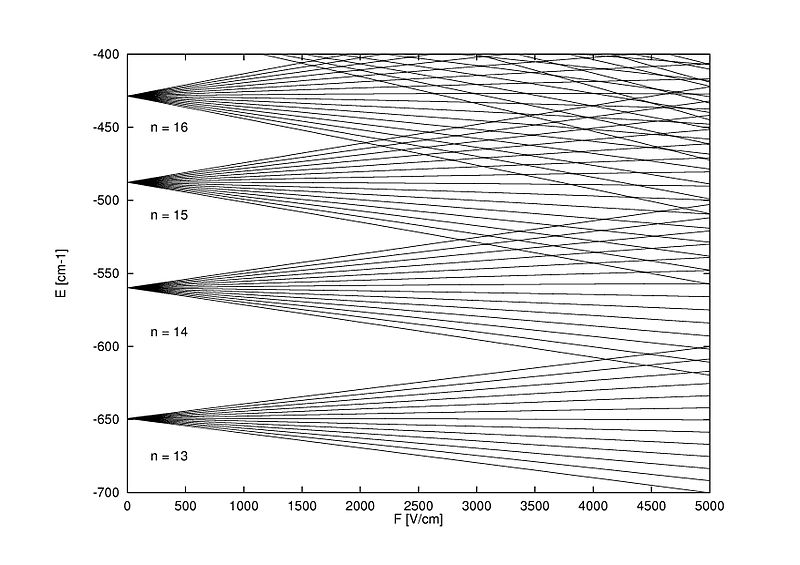The key difference between linear and quadratic stark effect is that linear Stark effect occurs due to a dipole moment that arises from a naturally occurring non-symmetric distribution of electrical charge, whereas quadratic Stark effect arises due to a dipole moment that is induced by the external field.
Stark effect is the splitting of spectral lines observed when radiating atoms, ions, or molecules are subjected to a strong electric field. This effect was first discovered by the German scientist Johannes Stark. The effect was named after him.
CONTENTS
1. Overview and Key Difference
2. What is Linear Stark Effect
3. What is Quadratic Stark Effect
4. Linear vs Quadratic Stark Effect in Tabular Form
5. Summary – Linear vs Quadratic Stark Effect
What is Linear Stark Effect?
Linear stark effect is the series of spectral lines that are produced when transitions between the energy levels are symmetric. In this type of effect, the difference between the energy levels (Δε ) is proportional to the applied electric field (E). The relationship is as follows:
Δε∝ E
Generally, the linear stark effect is characteristic of hydrogen that occurs in low strength electric fields. Typically, the energy level of a hydrogen atom having a given principal quantum number “n” tends to split symmetrically into 2n-1 sublevels. Moreover, we can observe this type of stark effect in hydrogen-like atoms such as He+, Li+2 and Be+3.

Figure 01: Stark Effect
Typically, the magnitude of the linear effect is comparatively large. In addition, this effect can be found in atoms with symmetry and a constant dipole moment.
What is Quadratic Stark Effect?
The quadratic stark effect is the series of spectral lines where the lines pattern is asymmetric. In this type of stark effect, the difference between the energy levels (Δε ) is proportional to the square of the applied electric field (E). The relationship is as follows:
Δε∝ E2
This type of stark effect is common in many-electron atoms. Typically, the magnitude of the quadratic effect is comparatively small. Furthermore, this effect can be found in atoms with asymmetry and a changing dipole moment.
What is the Difference Between Linear and Quadratic Stark Effect?
The Stark effect arises due to the interaction between the electric moment of the atom and the external electric field. There are two types of Stark effect; they are the linear stark effect and the quadratic stark effect. The key difference between linear and quadratic stark effect is that the linear Stark effect occurs due to a dipole moment that arises from a naturally occurring non-symmetric distribution of electrical charge, whereas the quadratic Stark effect arises due to a dipole moment that is induced by the external field.
Moreover, the magnitude of the linear Stark effect is comparatively high, while the magnitude of the quadratic stark effect is comparatively small. In addition to these differences, the linear Stark effect can be found in hydrogen and hydrogen-like low-electron atoms, whereas the quadratic stark effect can be observed in many-electron atoms.
The following infographic summarizes the differences between linear and quadratic stark effect in tabular form.
Summary – Linear vs Quadratic Stark Effect
The Stark effect arises due to the interaction between the electric moment of the atom and the external electric field. We can divide it into two categories as linear stark effect and quadratic stark effect. The key difference between linear and quadratic stark effect is that the linear Stark effect arises due to a dipole moment occurring from a naturally occurring non-symmetric distribution of electrical charge, whereas the quadratic Stark effect arises due to a dipole moment that is induced by the external field.
Reference:
1. “Stark Effect.” Farlex Encyclopedia.
Image Courtesy:
1. “Hfspec1” By Michael Courtney – Own work (CC BY-SA 3.0) via Commons Wikimedia
ncG1vNJzZmivp6x7pbXFn5yrnZ6YsqOx07CcnqZemLyue9ahmK1lmah6tbTEZpuinpaav6a6wp5km52krLKmuoyloKedkad6orrDZqiumZSnrrW1wmaqrZmioHqmssWemq1n